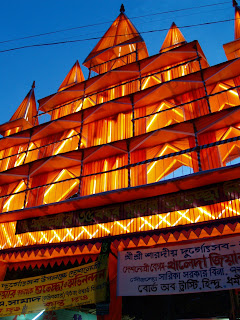The build up to Christmas Eve is very different. There is no sense that Christmas is just about the corner – I could only hear Slade in my own room – but to engender some of the spirit, I had a small Christmas party at my NGO, and brought some Christmas pudding that they all could try. Most of the people there brought their wives and kids and also some samosas and home-baked cakes and I was able to tell a little about Christmas and how we celebrate it. The pudding went down well, though the kids ate only the ice cream and then stuffed their faces with samosas. But at least they tried a small bit: one even spat it out on the floor. I didn’t think it was that bad.
I managed to escape sometime around 6.30 and rushed back to our flat to collect the Muppets Christmas Carol (still highly recommended for those that have never seen it) before going to a Filipino Christmas Party at another VSO flat. There are probably more Filipinos than any other nationality here, and they celebrate Christmas on the 24th. So we had fish curries, noodles, cakes and all sorts whilst some others murdered songs on a kareoke machine. But by nine it was time to move out, a little full on rice wine, to midnight mass.
Bangladesh is a unique place where midnight takes place at 10 pm. Ten is the cut off after which you are likely to be mugged and attacked (one volunteer was mugged later that evening at knife point), so things are moved forward. In 2004, eight churches were bombed by fundamentalists of one creed or another, and so the churches have been guarded by the RAB (the special police force whose particular speciality is extrajudicial killings – see Human Rights Watch’s latest report). Tim and I rushed (in as much as this is possible in Dhaka traffic) up to Banani Catholic Church and met Georgia and her mum for the mass. And this was an experience not to be missed.
Firstly, remember that this is supposed to be a catholic church, or al that follows will not seem strange and wondrous. The opening ‘hymn’ – to which two priests brought in a plastic doll called Jesus and laid at the alter – was Johnny Mathiers ‘When a Child was Born’. This stupendous start was bettered when the next hymn appeared: Boney M singing their Christmas song, which I do not know the name of but has the video of them all in big Eskimo suits.
Already we had some level of sacrilege, but this was further compounded by the addition of evangelical tones. Through out we had to have open hands praying, alleluia refrains, Silent Night in millions of languages and other things not befitting Catholic services. There was no fire and brimstone, going to hell and general misery, but this horrendous fusion of the worst of all churches. One of the priests would not have looked out of place on Craggy Island. But once we had finished our singing of pop songs and one carol, we could leave and struggled back to our flat, where I finished watching the Muppets, for a more Christmasy feeling than the church.
Christmas morning in the bright, dusty sun was more than a little strange, with calls to prayer darting around and life for most being no different. Tim and I dashed up to the Mohammadpur Market to get new potatoes, carrots, beans, spinage, cauliflower and peas, and then topped this up with bombay mix, pringles, pistachios, milk and all else needed for a full blown dinner. By 12 or so we were able to start peeling vegetables for 15 people and then try to get the little electric oven that had appeared in the induction flat to roast potatoes and garlic. We had five ready roasted chickens to enable us to eat meat that was not boiled or fried or stewed, and then spent the next three hours laying out mountains of veg, grapes and oranges, dates and nuts, Christmas cake and pudding and mince pies. We also had chocolate and fruit pastels, jelly babies and After Eights so that by 4 I felt pretty sick (and I think most did). The assault of rich and sugary foods after the relative austerity of cooking here sent stomachs into freefall, but it was certainly worth it, even if I am now on antibiotics for dysentery.
We had a pirated copy of Casino Royal to for the early evening, and then finished off the wine, brandy, rice wine and some cheese specially arrived from England (you can’t get it here) and let the evening pass, interrupted only by more calls to prayer: if only we could get hold of the mike and play Wizzard through it.
Boxing day and Christmas was definitely over, though most Bangladeshi’s hadn’t noticed it had passed. We stumbled about Gulshan trying to buy a plane ticket for our Sundarbans trip, and whilst I got this, Tim decided that it would be a prudent time to learn to ride a rickshaw. We are pretty sure that the bloke sitting in his car that suffered the collision Tim engineered was not expecting to see a rickshawala being driven by a bedeshi, and this may have been enough to prevent him leaping out and adding a gash to Tim of the same length and depth as the scratch embedded in his paint work. It turns out that rickshaws are wider than you’d think, and worthy of more respect when being driven by the inexperienced. We got out of there as quickly as possible, and discovered the British High Commission Club is a lot cheaper than our own and has better bacon.
And this summarised quite adequately Christmas in Bangladesh, a hot, dusty and noisy one, but with a certain level of charm and a lot of fun.



 Path
Path



